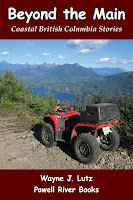KOZI Warm Off the Grid
When we decided to live in a float cabin on Powell Lake, we had to learn new off-the-grid ways of doing everyday tasks. Winter can be challenging on the lake, but one of our favorite times of the year.
We stay warm and snug in our cabin even during snowstorms. Our "KOZI" wood-burning stove keeps the cabin warm day and night (as long as Wayne gets up to stoke it).
 Our KOZI doubles as a cooking surface, saving valuable propane for lights and a refrigerator. Using my cast iron dutch oven, I've cooked scrumptious pineapple upside down and apple-raisin spice cakes on top of the stove. Comfort foods are wonderful on a wintry day.
Our KOZI doubles as a cooking surface, saving valuable propane for lights and a refrigerator. Using my cast iron dutch oven, I've cooked scrumptious pineapple upside down and apple-raisin spice cakes on top of the stove. Comfort foods are wonderful on a wintry day.
We need lots of wood, so our friend John built us a wood storage float. Here we can cut, split, and store wood all summer so it will be ready for our winter needs.

The wood float keeps the extra weight off our cabin deck, but still makes it handy. I've built a wood storage shelf for the back bedroom. Here we can store enough wood for four days and nights of KOZI fires.
Here's just a sample of how we stay KOZI warm off the grid.
 "Debris Field" in Up the Winter Trail tells about some of our wood gathering exploits.
"Debris Field" in Up the Winter Trail tells about some of our wood gathering exploits.
Let us hear about some of your winter stories. -- Margy





















Sounds dreamy! I too would like to live/work in an off the grid floating cabin. That's how I found you. Living in Alberta as I do it's hard to find floating cabin-dwellers for cold climates who are conscious of ecological impact. Any chance you'd share some wisdom along with your wit on the topic? marty@what-if.ca
ReplyDeleteGood to hear from you Marty. Our climate in Powell River, BC, is milder than Alberta, so the challenge of winter cabin living is somewhat less for us. We get snow, but it usually melts in a few days. Rain is the name of the game for us. I will be focusing on more off-the-grid topics in future blogs for sure.
ReplyDeleteOne advantage we have is that Powell Lake never freezes. The deepest part is 1200 feet. Right under our cabin (15 feet from shore) it is already 90 feet deep. The down side is that the lake acts like an inland sea and we can get wind waves over 3 feet high in open water. On days like that we either stay in town or hunker down in our cabin protectively tucked into the Hole in the Wall. Check the link for more information about our cabin. Hope to hear from you again soon.
Margy